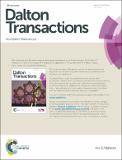Characterization and photocatalytic behavior of 2,9-di(aryl)-1,10-phenanthroline copper(I) complexes
Abstract
The synthesis, characterization, photophysical properties, theoretical calculations, and catalytic studies of 2,9-di(aryl)-1,10-phenanthroline copper (I) complexes are described. Specifically, this study made use of di(aryl)-1,10-phenanthroline ligands including 2,9-di(4-methoxyphenyl)-1,10-phenanthroline ( 1 ), 2,9-di(4-hydroxyphenyl)-1,10-phenanthroline ( 2 ), 2,9-di(4-methoxy-3-methylphenyl)-1,10-phenanthroline ( 3 ), and 2,9-di(4-hydroxy-3-methylphenyl)-1,10-phenanthroline ( 4 ). The 2:1 ligand-to-metal complexes, as PF6- salts, i.e., ([Cu·( 1 )2]PF6, [Cu·( 2 )2]PF6, [Cu·( 3 )2]PF6, and [Cu·( 4 )2]PF6) have been isolated and characterized. The structures of ligands 1 and 2 and complexes [Cu·( 1 )2]PF6 and [Cu·( 3 )2]PF6 have been determined by single-crystal X-ray analysis. The photoredox catalytic activity of these copper(I) complexes was investigated in an atom-transfer radical-addition (ATRA) reaction and the results showed fairly efficient activity, with a strong wavelength dependence. In order to better understand the observed catalytic activity, photophysical emission and absorption studies, and DFT calculations were also performed. It was determined that when the excitation wavelength was appropriate for exciting into the LUMO+1 or LUMO+2, catalysis would occur. On the contrary, excitations into the LUMO resulted in no observable catalysis. In light of these results, a mechanism for the ATRA photoredox catalytic cycle has been proposed.
Citation
Cetin , M M , Hodson , R T , Hart , C R , Cordes , D B , Findlater , M , Casadonte, Jr. , D J , Cozzolino , A F & Mayer , M F 2017 , ' Characterization and photocatalytic behavior of 2,9-di(aryl)-1,10-phenanthroline copper(I) complexes ' , Dalton Transactions , vol. 46 , no. 20 , pp. 6553-6569 . https://doi.org/10.1039/C7DT00400A
Publication
Dalton Transactions
Status
Peer reviewed
ISSN
1477-9226Type
Journal article
Description
Financial support from the National Science Foundation (MFM research grant CHE-0847736 and NMR instrument grant CHE-1048553) and the Robert A. Welch Foundation (AFC grant D-1838 and MF grant D-1807) are gratefully acknowledged.Collections
Items in the St Andrews Research Repository are protected by copyright, with all rights reserved, unless otherwise indicated.

